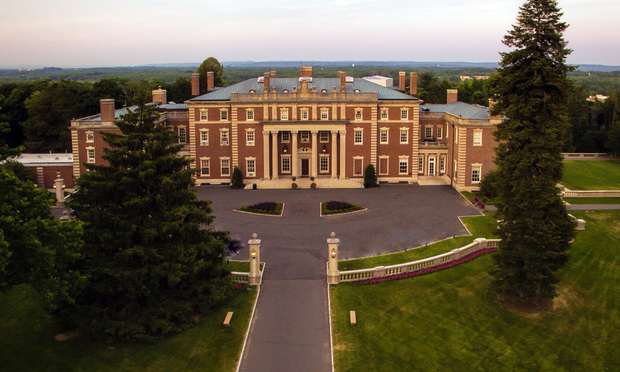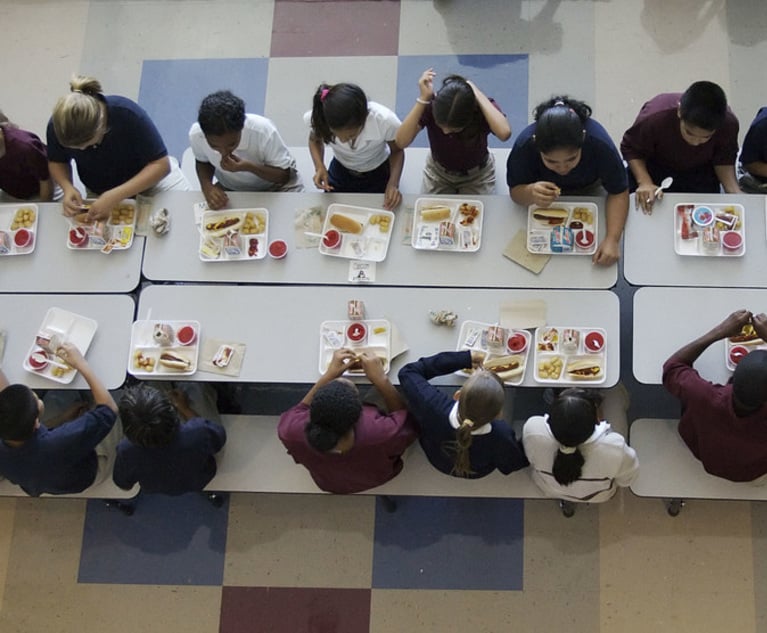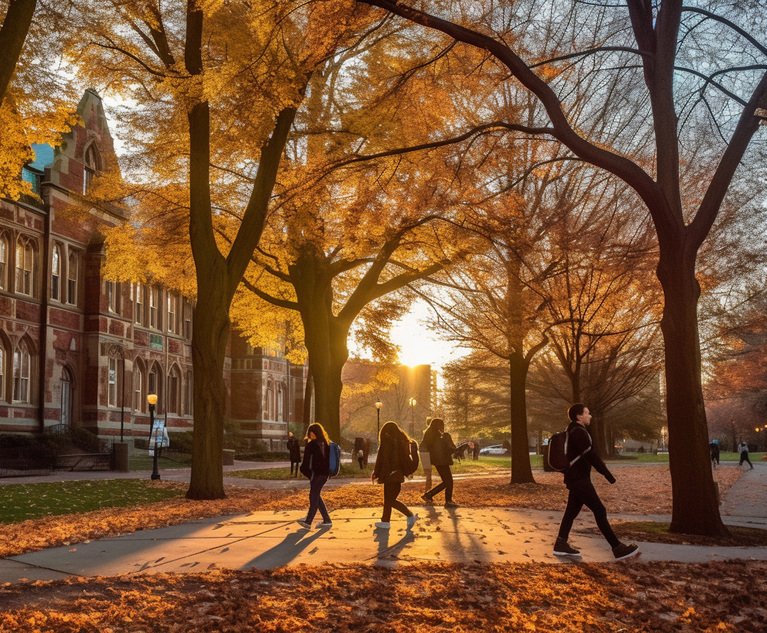Fairleigh Dickinson Had Duty to Warn Worker of Unsafe Roof
The university previously repaired the library roof but "remained silent about deteriorating joints, waterproof problems, mismatching caulk, and previous repairs to the top of the rails and facing joints," the Appellate Division said.
October 11, 2019 at 06:57 AM
4 minute read
 Vanderbilt-Twombly mansion, Florham Campus, Fairleigh Dickinson University.
Vanderbilt-Twombly mansion, Florham Campus, Fairleigh Dickinson University.
It was Fairleigh Dickinson University's duty to inform an electrical worker that the roof over its library had a latent defect and was unsafe to work on, a state appeals court has ruled.
Plaintiff Sonny Cabrera Jr., an employee of KB Electric Services Company Inc., ultimately fell from the roof and sustained injuries, which led to his filing suit against the school. The Hartford Insurance Co. and KB Electric are third-party defendants.
An Appellate Division panel in a per curiam decision reversed a trial judge's ruling that the university had no duty to inform KB Electric, the company it hired to do work on campus, about the dangerous condition of the roof prior to sending Cabrera to change light bulbs there.
"Under the facts here, we disagree and reverse," wrote Judges Douglas M. Fasciale and Stephanie Ann Mitterhoff in the Oct. 8 opinion. "It is undisputed that a dangerous condition existed."
"The landowner's duty includes the obligation of making a reasonable inspection to discover defective and hazardous conditions. Here, defendant knew the dangerous condition existed before the accident," said the judges.
The personal injury case was on appeal from Passaic County Superior Court.
Dennis G. Polizzi of Pitts & Polizzi in Clifton represented Cabrera. Polizzi was not immediately available to comment.
Richard Evan Barber of Haworth Barber & Gerstman in Hackensack, who represented Fairleigh Dickinson University, couldn't be reached for comment.
Cabrera appealed the grant of summary judgment to Fairleigh Dickinson.
According to the decision, Cabrera typically would access the library roof by using a KB bucket truck. From the bucket, he would do his repair work, while wearing a fall-protection harness that was attached to the bucket. But in this instance the suit contends the school interfered with that practice.
After directing Cabrera where to work, the school parked its own truck where the bucket truck needed to be, rendering Cabrera unable to access the roof from the bucket, according to the decision.
As a result, Cabrera used an alternate route to access the roof. While there, he leaned on a balustrade to retrieve pliers that another worker tossed him. He fell when the balustrade gave way at the northeast corner of the library building, according to the decision.
A preaccident report by a university-hired engineer who inspected the area where Cabrera fell stated that the roof's balustrades were not reinforced and lacked any mechanical fasteners and documented other deterioration, the court noted. But the engineer also said the solid piers at each side of the balustrades likely would hold under anticipated normal loads, "except for major seismic activity."
"Indeed, defendant's representative testified that the university repaired the balustrades before the accident," wrote the judges. "Although defendant knew about the latent dangerous condition, and even though defendant prevented plaintiff from accessing the roof using the bucket, defendant remained silent about deteriorating joints, waterproof problems, mismatching caulk, and previous repairs to the top of the rails and facing joints."
"An occupier of land owes a duty to his invitee to use reasonable care to make the premises safe … ," said the panel, citing Olivo v. Owens–Illinois Inc. "And a landowner has 'the duty to provide a reasonably safe working place' for an independent contractor he or she hires,'" the panel wrote.
The court said it understood the university's contention that such duty does not relate to known hazards which are part of, or incidental to, the very work an independent contractor is hired to perform.
But, said the panel, "Here, the dangerous condition did not pertain to an operational hazard that was obvious and visible to plaintiff upon ordinary observation," the opinion said. "It was hidden; only defendant knew about it. And the dangerous condition was not part of or incidental to repairing light bulbs."
The judges noted how the engineer who inspected the roof and verified the solid piers as being stable and substantial was also in the dark.
"Only defendant knew that this was not the case," said the panel. "Reversed."
This content has been archived. It is available through our partners, LexisNexis® and Bloomberg Law.
To view this content, please continue to their sites.
Not a Lexis Subscriber?
Subscribe Now
Not a Bloomberg Law Subscriber?
Subscribe Now
NOT FOR REPRINT
© 2025 ALM Global, LLC, All Rights Reserved. Request academic re-use from www.copyright.com. All other uses, submit a request to [email protected]. For more information visit Asset & Logo Licensing.
You Might Like
View All
Seton Hall Escapes COVID-19 Wrongful Death Suit After Student Found Dead in Dorm
4 minute read
Where CFPB Enforcement Stops Short on Curbing School Lunch Fees, Class Action Complaint Steps Up
5 minute read
From 'Confusing Labyrinth' to Speeding 'Roller Coaster': Uncertainty Reigns in Title IX as Litigators Await Second Trump Admin
6 minute read
Trending Stories
- 1'It's Not Going to Be Pretty': PayPal, Capital One Face Novel Class Actions Over 'Poaching' Commissions Owed Influencers
- 211th Circuit Rejects Trump's Emergency Request as DOJ Prepares to Release Special Counsel's Final Report
- 3Supreme Court Takes Up Challenge to ACA Task Force
- 4'Tragedy of Unspeakable Proportions:' Could Edison, DWP, Face Lawsuits Over LA Wildfires?
- 5Meta Pulls Plug on DEI Programs
Who Got The Work
Michael G. Bongiorno, Andrew Scott Dulberg and Elizabeth E. Driscoll from Wilmer Cutler Pickering Hale and Dorr have stepped in to represent Symbotic Inc., an A.I.-enabled technology platform that focuses on increasing supply chain efficiency, and other defendants in a pending shareholder derivative lawsuit. The case, filed Oct. 2 in Massachusetts District Court by the Brown Law Firm on behalf of Stephen Austen, accuses certain officers and directors of misleading investors in regard to Symbotic's potential for margin growth by failing to disclose that the company was not equipped to timely deploy its systems or manage expenses through project delays. The case, assigned to U.S. District Judge Nathaniel M. Gorton, is 1:24-cv-12522, Austen v. Cohen et al.
Who Got The Work
Edmund Polubinski and Marie Killmond of Davis Polk & Wardwell have entered appearances for data platform software development company MongoDB and other defendants in a pending shareholder derivative lawsuit. The action, filed Oct. 7 in New York Southern District Court by the Brown Law Firm, accuses the company's directors and/or officers of falsely expressing confidence in the company’s restructuring of its sales incentive plan and downplaying the severity of decreases in its upfront commitments. The case is 1:24-cv-07594, Roy v. Ittycheria et al.
Who Got The Work
Amy O. Bruchs and Kurt F. Ellison of Michael Best & Friedrich have entered appearances for Epic Systems Corp. in a pending employment discrimination lawsuit. The suit was filed Sept. 7 in Wisconsin Western District Court by Levine Eisberner LLC and Siri & Glimstad on behalf of a project manager who claims that he was wrongfully terminated after applying for a religious exemption to the defendant's COVID-19 vaccine mandate. The case, assigned to U.S. Magistrate Judge Anita Marie Boor, is 3:24-cv-00630, Secker, Nathan v. Epic Systems Corporation.
Who Got The Work
David X. Sullivan, Thomas J. Finn and Gregory A. Hall from McCarter & English have entered appearances for Sunrun Installation Services in a pending civil rights lawsuit. The complaint was filed Sept. 4 in Connecticut District Court by attorney Robert M. Berke on behalf of former employee George Edward Steins, who was arrested and charged with employing an unregistered home improvement salesperson. The complaint alleges that had Sunrun informed the Connecticut Department of Consumer Protection that the plaintiff's employment had ended in 2017 and that he no longer held Sunrun's home improvement contractor license, he would not have been hit with charges, which were dismissed in May 2024. The case, assigned to U.S. District Judge Jeffrey A. Meyer, is 3:24-cv-01423, Steins v. Sunrun, Inc. et al.
Who Got The Work
Greenberg Traurig shareholder Joshua L. Raskin has entered an appearance for boohoo.com UK Ltd. in a pending patent infringement lawsuit. The suit, filed Sept. 3 in Texas Eastern District Court by Rozier Hardt McDonough on behalf of Alto Dynamics, asserts five patents related to an online shopping platform. The case, assigned to U.S. District Judge Rodney Gilstrap, is 2:24-cv-00719, Alto Dynamics, LLC v. boohoo.com UK Limited.
Featured Firms
Law Offices of Gary Martin Hays & Associates, P.C.
(470) 294-1674
Law Offices of Mark E. Salomone
(857) 444-6468
Smith & Hassler
(713) 739-1250






